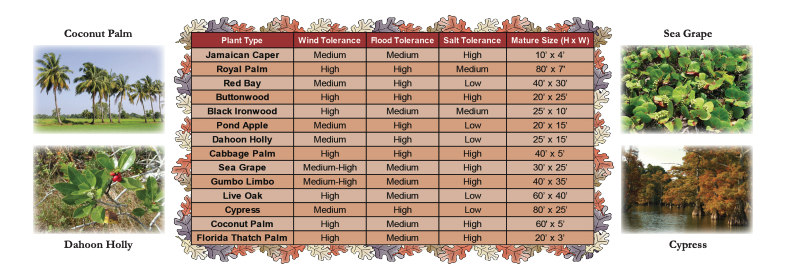By Chris Kittleson, Director of Loss Control Technical Services - Public Risk Underwriters of Florida, Inc.

With the recent post hurricane activities of hurricane Irma, serious consideration should be given to hurricane-scaping landscaping. Hurricane-scaping is a process of taking the necessary steps to modify your landscaping to reduce storm damage. The process consists of selecting storm wise trees, addressing inland flooding/storm surge exposures to your landscaping as well as providing ongoing landscape maintenance.
Post storm analysis indicates that native trees/shrubs that are even branched with low centers of gravity and have deep root systems fare better in hurricane-force winds. Species like sea grapes and gumbo limbo quickly shed their leaves in hurricane-force winds, but the structures of these even-branched trees tend to remain intact and the foliage quickly re-grows. Native palms such as coconut, cabbage and thatch palms are also highly adapted to strong winds and are known to survive unscathed.
When planting trees one should consider their eventual size to avoid future conflicts with buildings, fences and power lines. Mature tree height is extremely important to consider under power lines. When trees are allowed to grow into power lines, they pose a year-round maintenance issue for the power company and increase the chances that power will be interrupted after a storm.
Flood tolerance and local storm-surge potential should also be taken into consideration. If areas are prone to inland flooding select landscaping that is flood-tolerant. For coastal landscaping you need to consider the possibility of a storm surge that could bring large amounts of salt water inland. Selection of salt-tolerant specifies such as coconut palms, sea grape and gumbo limbo can be utilized to minimize post-storm damage.
As part of an overall landscape maintenance plan pre/post storm preparation activities are equally important. That being said, it is always recommended to work with a Certified Arborist in planning for hurricane season to determine what needs to be completed pre/post hurricane. In advance of hurricane season brown fronds and seed pods on palms should be removed along with coconuts and harvest items, i.e. fruits, which are mature enough to pick. In addition, provide for the staking of small trees to secure them against heavy winds. Subsequent to a hurricane, take time to properly access landscaping damage. Secure and/or remove hazards and consider delaying the pruning and removal of trees and shrubs for as long as possible. The damage to the landscaping may look severe initially, but wind-whipped trees and shrubs can improve in appearance in a matter of months. When dealing with flooded areas, check the drainage system to remove any blockage to assist in reducing further damage to water-intolerant species.
Please refer to the Storm-Wise Landscaping table below to help you learn more about landscaping that is better suited to survive hurricanes:

